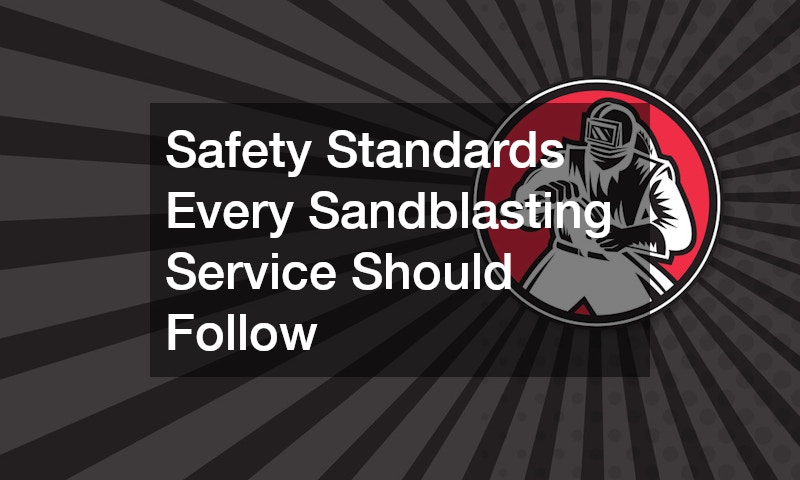

Sandblasting is an effective method for cleaning, stripping, and preparing surfaces, but it also comes with significant safety risks if not performed properly. This article discusses the essential safety standards every sandblasting service should adhere to in order to ensure the safety of workers and compliance with industry regulations. From proper protective gear and ventilation systems to the handling of abrasive materials and equipment maintenance, following these guidelines helps prevent workplace accidents and long-term health issues.
By understanding and enforcing these safety practices, both employers and technicians can maintain a productive, compliant, and secure work environment that prioritizes safety as much as performance.
What Personal Protective Equipment (PPE) is Necessary for Sandblasting?
Personal Protective Equipment (PPE) is crucial for ensuring the safety of workers involved in sandblasting. The type of PPE required varies depending on the specific hazards associated with the job. Masks, gloves, and helmets are just a few examples of the gear needed to protect against abrasives and particles.
In addition to basic PPE, specialized equipment is available to enhance worker safety further. This includes respirators with appropriate filters to ensure that no harmful dust particles are inhaled during the process. Ensuring that all PPE is properly maintained and inspected regularly is paramount to worker safety.
Furthermore, it is essential to provide thorough training on how to utilize and maintain PPE effectively. Workers should be aware of the proper way to wear and care for their protective gear to avoid accidents that may lead to injury. Investing in high-quality PPE products can result in a safer work environment and reduce potential hazards significantly.
What Are the Key Safety Regulations for Sandblasting Operations?
Compliance with safety regulations is vital for any sandblasting operation. These regulations often originate from multiple authority levels, including local, state, and federal mandates. OSHA (Occupational Safety and Health Administration) sets forth specific guidelines that sandblasting services must follow.
For instance, adhering to the permissible exposure limits (PELs) for airborne contaminants is required. Services must also ensure that work areas are properly ventilated, and safety data sheets (SDS) for materials used in sandblasting are available and accessible to all workers, fostering an informed and compliant work environment.
Additionally, being aware of the Environmental Protection Agency (EPA) regulations regarding waste disposal and emissions can prevent future liabilities. Organizations must regularly conduct audits and assessments to ensure compliance, thereby protecting their employees and safeguarding the environment.
How Can Sandblasting Services Prevent Respiratory Hazards?
Respiratory hazards are one of the most significant risks involved in sandblasting. The use of silica and other abrasive materials can lead to severe health issues, including chronic lung diseases and silicosis, if proper precautions are not in place. Effective ventilation systems can help to mitigate these risks by reducing airborne contaminants and maintaining consistent airflow in the work environment. Regular inspection and maintenance of these systems are equally important to ensure continued effectiveness over time.
Additionally, the implementation of wet sandblasting techniques can significantly diminish dust levels. By utilizing water or other suppressants during the sandblasting process, dust generated can be minimized, providing a safer atmosphere for workers. This approach also benefits equipment, reducing the likelihood of wear and tear while promoting smoother, more controlled operations.
It is also pivotal to monitor the air quality consistently in the sandblasting area. Utilizing air quality monitoring devices can help detect harmful levels of dust and other pollutants, allowing for timely interventions to protect workers before exposure becomes hazardous. Combining modern technology, proper training, and proactive safety methods ensures a healthier, more sustainable work environment committed to long-term worker well-being.
What Safety Training Should Sandblasting Personnel Receive?
Safety training is essential for ensuring that all personnel are aware of their responsibilities and the risks associated with sandblasting. Comprehensive training programs should cover topics such as the proper usage of PPE, hazard communication, and emergency response procedures. Interactive training sessions can be particularly effective in engaging workers and reinforcing learning.
Additionally, ongoing education is critical in this field due to constantly evolving safety standards and regulations. Regular refresher courses can help maintain high safety awareness levels among workers and support compliance with legal requirements. Keeping personnel informed about the latest safety practices and innovations, such as new PPE technologies or updated regulations, ensures a proactive approach to safety.
Lastly, organizations should emphasize a culture of safety where all employees feel responsible for upholding safety standards. Encouraging workers to report unsafe practices and conditions can lead to improvements and prevent incidents. By fostering an environment of open communication regarding safety practices, companies can build a more resilient workforce dedicated to maintaining a safe workplace.
Adhering to safety standards in sandblasting services not only protects workers but also enhances operational efficiency and regulatory compliance. By prioritizing PPE, understanding regulations, mitigating respiratory hazards, and investing in thorough training, businesses can ensure a safer work environment that benefits everyone involved.



